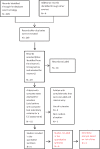Effect of Combined Diclofenac and B Vitamins (Thiamine, Pyridoxine, and Cyanocobalamin) for Low Back Pain Management: Systematic Review and Meta-analysis
- PMID: 31529101
- PMCID: PMC7139211
- DOI: 10.1093/pm/pnz216
Effect of Combined Diclofenac and B Vitamins (Thiamine, Pyridoxine, and Cyanocobalamin) for Low Back Pain Management: Systematic Review and Meta-analysis
Abstract
Background: Cumulative evidence suggests an analgesic effect of thiamine, pyridoxine, and cyanocobalamin (TPC) in monotherapy, and also when combined with nonsteroidal anti-inflammatory drugs (NSAIDs), particularly diclofenac, in a synergistic manner. The aim of this review was to determine the effects of diclofenac combined with TPC compared with diclofenac monotherapy for low back pain (LBP) management.
Methods: We searched for randomized clinical trials on the MEDLINE, EMBASE, LILACS, and Cochrane databases of records of clinical trials, among other sources. We evaluated the risk of bias regarding randomization, allocation concealment, blinding, incomplete outcome data, selective reporting, and other biases. A random-effects meta-analysis to examine patients with acute LBP (N = 1,108 adults) was performed, along with a subsequent sensitivity analysis.
Results: Five studies in patients with LBP were included in the qualitative synthesis. Four of these studies in acute LBP were included in the first meta-analysis. A sensitivity test based on risk of bias (three moderate- to high-quality studies) found that the combination therapy of diclofenac plus TPC was associated with a significant reduction in the duration of treatment (around 50%) compared with diclofenac monotherapy (odds ratio = 2.23, 95% confidence interval = 1.59 to 3.13, P < 0.00001). We found no differences in the safety profile and patient satisfaction.
Conclusions: This meta-analysis demonstrated that combination therapy of diclofenac with TPC might have an analgesic superiority compared with diclofenac monotherapy in acute LBP. However, there is not enough evidence to recommend this therapy in other types of pain due to the scarcity of high-quality studies.
Keywords: B Vitamins; Back Pain; Diclofenac; Meta-analysis; Systematic Review.
© 2019 American Academy of Pain Medicine.
Figures






Similar articles
-
A Randomized Control Trial of Dexketoprofen/Vitamin B (Thiamine, Pyridoxine and Cyanocobalamin) Fixed-Dose Combination in Post-Traumatic Grade I-II Cervical Sprains.Clin Drug Investig. 2024 Jun;44(6):413-424. doi: 10.1007/s40261-024-01370-2. Epub 2024 Jun 6. Clin Drug Investig. 2024. PMID: 38842764 Free PMC article. Clinical Trial.
-
Non-steroidal anti-inflammatory drugs for acute low back pain.Cochrane Database Syst Rev. 2020 Apr 16;4(4):CD013581. doi: 10.1002/14651858.CD013581. Cochrane Database Syst Rev. 2020. PMID: 32297973 Free PMC article.
-
Tibetan herbal pain-relieving plaster for low back pain: A systematic review and meta-analysis.Biomed Pharmacother. 2021 Aug;140:111727. doi: 10.1016/j.biopha.2021.111727. Epub 2021 May 18. Biomed Pharmacother. 2021. PMID: 34015584 Free PMC article.
-
Diclofenac plus B vitamins versus diclofenac monotherapy in lumbago: the DOLOR study.Curr Med Res Opin. 2009 Nov;25(11):2589-99. doi: 10.3111/13696990903246911. Curr Med Res Opin. 2009. PMID: 19731994 Clinical Trial.
-
[Shortening diclofenac therapy by B vitamins. Results of a randomized double-blind study, diclofenac 50 mg versus diclofenac 50 mg plus B vitamins, in painful spinal diseases with degenerative changes].Z Rheumatol. 1988 Sep-Oct;47(5):351-62. Z Rheumatol. 1988. PMID: 3071032 Clinical Trial. German.
Cited by
-
The Impact of Nutrition on Pain: A Narrative Review of Recent Literature.Curr Pain Headache Rep. 2024 Oct;28(10):1059-1066. doi: 10.1007/s11916-024-01275-x. Epub 2024 Jun 14. Curr Pain Headache Rep. 2024. PMID: 38874851 Review.
-
A Randomized Control Trial of Dexketoprofen/Vitamin B (Thiamine, Pyridoxine and Cyanocobalamin) Fixed-Dose Combination in Post-Traumatic Grade I-II Cervical Sprains.Clin Drug Investig. 2024 Jun;44(6):413-424. doi: 10.1007/s40261-024-01370-2. Epub 2024 Jun 6. Clin Drug Investig. 2024. PMID: 38842764 Free PMC article. Clinical Trial.
-
Increase in Lower Limb Strength after Multimodal Pain Management in Patients with Low Back Pain.Medicina (Kaunas). 2022 Jun 22;58(7):837. doi: 10.3390/medicina58070837. Medicina (Kaunas). 2022. PMID: 35888556 Free PMC article.
-
The importance of thiamine (vitamin B1) in humans.Biosci Rep. 2023 Oct 31;43(10):BSR20230374. doi: 10.1042/BSR20230374. Biosci Rep. 2023. PMID: 37389565 Free PMC article.
-
Acupotomy for third lumbar vertebrae transverse process syndrome: A protocol for systematic review.Medicine (Baltimore). 2020 Jul 17;99(29):e21072. doi: 10.1097/MD.0000000000021072. Medicine (Baltimore). 2020. PMID: 32702850 Free PMC article.
References
-
- Hoy D, Bain C, Williams G, et al. A systematic review of the global prevalence of low back pain. Arthritis Rheum 2012;64(6):2028–37. - PubMed
-
- Manchikanti L, Singh V, Falco FJE, Benyamin RM, Hirsch JA.. Epidemiology of low back pain in adults. Neuromodulation 2014;17(Suppl 2):3–10. - PubMed
-
- Deyo RA, Mirza SK, Martin BI.. Back pain prevalence and visit rates: Estimates from U.S. national surveys, 2002. Spine 2006;31(23):2724–7. - PubMed
Publication types
MeSH terms
Substances
LinkOut - more resources
Full Text Sources
Medical
Miscellaneous

